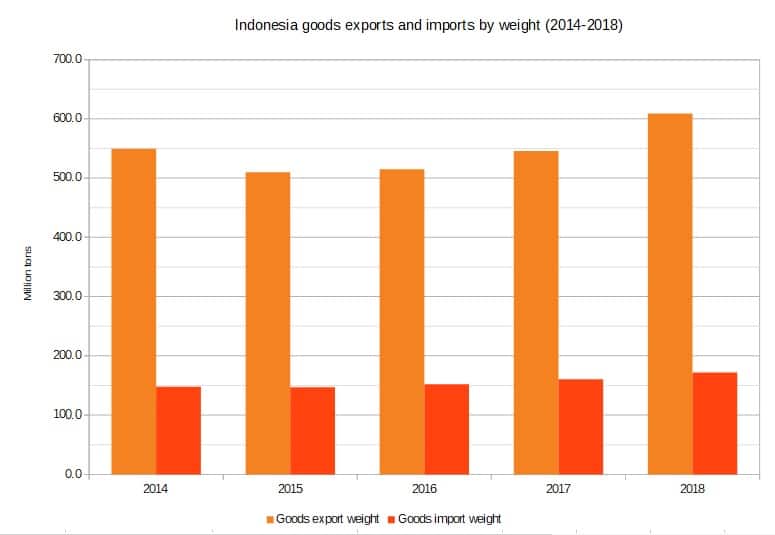Taiwan-based box-shipping line, Yang Ming, has set up shop in Jakarta, Indonesia, with joint venture partners. The new subsidiary will be known as “PT Yang Ming Shipping Indonesia”.
Heading up Yang Ming in Indonesia
The subsidiary will be headed up by Benson Chou, who has been officially nominated as “President Director”.
Chou has had a 30-year career with Yang Ming and has served in a managerial capacity in the group’s Taiwan headquarters and in its Dalian, China, offices. He also did a four-year stint in Indonesia starting in 2009.
Rationale for expansion
A Yang Ming spokesperson told FreightWaves that the group was setting up in Indonesia for the purposes of localizing its business in the Indonesian market. In a public statement, Yang Ming noted that there has been “rapid economic growth in South East Asia” and that the global ocean shipping box lines are strengthening their regional services to meet growing market demand. Yang Ming adds that Indonesia has a strategic location and “great potential volume growth”.
Indonesia has been experiencing growth for much of the last five years according to International Monetary Fund data. In 2014, the total gross domestic product (current prices) of the Indonesian economy was $2,696.76 billion international dollars (on a parity of purchasing power basis). In 2018, that number had increased to $3,494.74 billion international dollars. That’s a 29.6 percent increase in five years.
In the same period, the volume of goods imported and exported has massively increased too. According to the Indonesian Central Bureau of Statistics, Indonesia exported 549.57 million metric tons of goods (all types) in 2014. A metric ton is equivalent to 2,204.6 U.S. pounds. By 2018 that number had jumped to 608.91 million tons, a 10.8 percent increase. It’s a similar story on imports. In 2014 the country imported 147.73 million tons of goods. By 2019, it imported 171.72 million tons. That’s a 16.2 percent increase.


Source: Badan Pusat Statistik / Indonesia Central Bureau of Statistics
Services, ships and routes
Yang Ming says its Indonesia subsidiary is focused on serving the local and overseas shippers, consignees and forwarders for import, export and trans-shipment cargoes in Indonesia. It will have three branch offices – one each in Surabaya, Panjang and Palembang.
The U.S. to Indonesia trade routes will be served by six services in Indonesia connecting to Yang Ming’s trans-Pacific services via the global hub ports of Singapore and Kaohsiung (Taiwan), as will services to Europe. Intra-Asia trades will be served via hubs at, again, Singapore and also Port Klang, Malaysia. Port Klang is the main port for the capital city of Malaysia, Kuala Lumpur.
Ships deployed on Indonesian calls will be in the 2,000 to 4,000 TEU range. Yang Ming operates six services at the major ports in Indonesia being Jakarta, Surabaya, Semarang and Belawan.
Ports of call rotations
Service CTI calls Shanghai (China), Ningbo (China), Shekou, Jakarta (Indonesia), Surabaya (Indonesia), Davao (Philippines), Kaohsiung (Taiwan) and back to Shanghai.
Service TSE calls at Taichung (Taiwan), Kaohsiung, Hong Kong, Haiphong (Vietnam), Da Nang (Vietnam), Cat Lai (Vietnam), Singapore, Port Klang (Malaysia), Jakarta before retracing the route in reverse port of call order (i.e. Port Klang, Singapore, Cat Lai etc).
SE5 calls at Port Klang, Singapore, Bangkok (Thailand), Singapore, Port Klang, Belawan (Indonesia) and back to Port Klang.
SS1 calls at Semarang (Indonesia) and Singapore.
SSX calls at Singapore, Surabaya (Indonesia), Singapore.
TPI calls at Kaohsiung, Surabaya and Jakarta.
According to Yang Ming, the group operates a fleet of 105 vessels with a 7.96-million deadweight and an operating capacity 686,000 twenty foot equivalent shipping containers as at March 2019.










